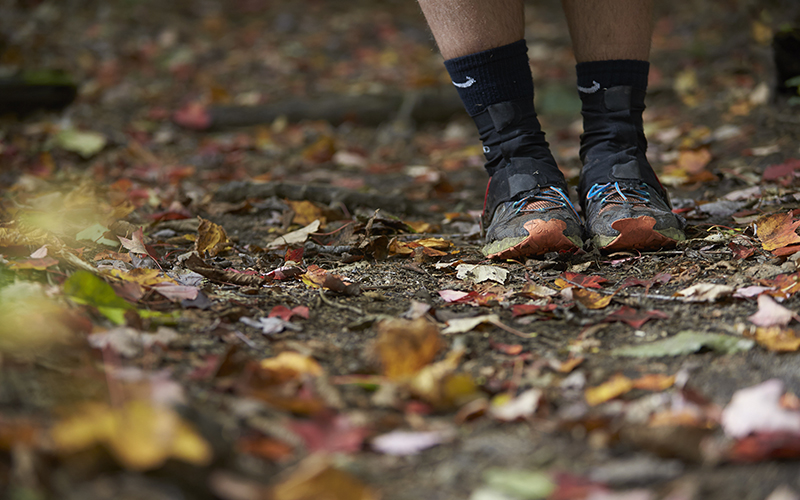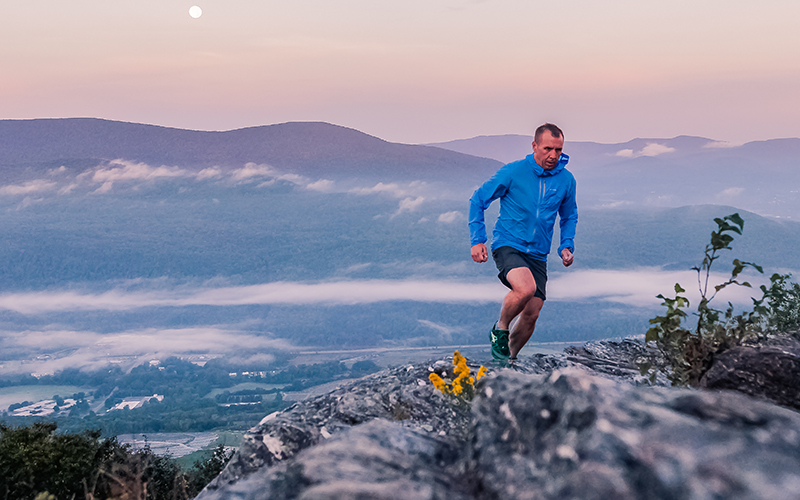
Hiking boots are built to last, with hard rubber underfoot and waterproof materials, but the added weight might be a deal breaker. Jayne LaFrate, AMC Photo Contest.
Think about hiking footwear as a spectrum. On one end are low-cut and lightweight trail running shoes, which feature stiffer soles, grippier tread, and a tighter fit than their road-running shoe cousins. On the other end are heavy-duty, trail stomping hiking boots that feature a high ankle collar, tough and durable materials, and a stiff and long-lasting sole. In between are hiking shoes, which feature elements of both boots (tougher materials and a more durable sole) and trail runners (low-cut and reduced weight, but still heavier than its lightweight counterpart).
The range of options and styles along this spectrum can be overwhelming, but the differences between them boil down to three fundamental factors: weight, durability, and the amount of ankle protection and stability they provide.
Weight
The weight on your feet has significant implications for your energy expenditure while hiking. Studies have shown that hiking with additional weight on your feet requires significantly more energy than carrying an equal amount of additional weight on your back. (Hence that old and roughly accurate adage, a pound on your feet is equal to five on your back.)
Ounces on your feet matter, especially if you’re trying to cover a lot of ground quickly with minimal effort. In this category, trail runners are the clear winner and an overwhelmingly popular choice for long-distance hikers. A survey of 2019 Appalachian Trail thru-hikers found that approximately three-quarters of them wore trail runners for their journey while less than 10 percent used hiking boots.
Most trail runners weigh in somewhere between 20 and 25 ounces per pair, substantially less than hiking boots, which generally weigh between two and a half and three pounds-plus per pair. Hiking shoes fall between the two, with most hovering right around the two-pound range.
Durability
Trail running shoes definitely weigh less than other hiking footwear. However, they are also less effective when it comes to durability, with most models wearing out and needing replacement after roughly 500 to 750 miles of use. The materials in the shoe uppers begin to fray and fall apart, and the softer grippy rubber underfoot wears down and loses tread. What’s more, the midsole found in many maximalist trail runners, which are specifically designed with extra cushioning, tends to collapse and lose its bounce as the miles pile up. Thru-hikers wearing trail runners typically go through multiple pairs over the course of their journey.
Hiking boots, on the other foot, are built to last thousands of trail miles, especially if they feature hard rubber underfoot, a deep tread in the sole, and an upper made from leather and not a combination of fabric, leather, and/or mesh, which is more prone to wearing out. Hiking shoes vary in their durability; most last longer than trail runners but fall well short of a hiking boot’s longevity. They generally use a combination fabric and leather on their uppers, which will start to wear out and begin to fray eventually, often in the heel.

Trail runners provide users with a lightweight option for swift travel, but you’ll need to replace them more often.
Protection and ankle support
The last crucial factor to consider is foot and ankle protection and support. Your needs here will depend a lot on the terrain you’ll be traveling and how much support you need for your ankles.
When it comes to protection, low-cut trail runners and hiking shoes do not shield your ankles from abrasion and scratches, which can be problematic and painful if you’re traveling through rocky, brushy, or otherwise sharp surroundings. (Not the best choice for bushwhacking adventures in the Northeast!) Trail runners also feature thinner materials, which makes your foot more vulnerable than with the tougher leather and thicker fabrics found in most hiking shoes and boots.
Next consider how much ankle support you need. Contrary to popular belief, a high ankle collar is not a primary source of ankle stability, though it definitely helps. Ankle support and stability instead comes from the stiffness of the sole, particularly how resistant it is to flexing side-to-side. This characteristic, known as torsional rigidity, is what provides a more stable platform underfoot. You can test this by holding a shoe at the front and back and twisting it side-to-side in your hand; the harder it is to twist, the more stable it will be.
Trail runners, hiking shoes, and hiking boots all feature adequate stability for most hikers and terrain. Trail runners and most hiking shoes generally flex more easily across the toes and forefoot than hiking boots; this makes them easier to walk in on moderate trails but reduces stability on rougher and more challenging terrain.
If you have solid ankles (no history of sprains or other ankle injuries) and pack only light to moderate weight (up to 30 pounds or so), both trail runners and hiking shoes provide ample stability for all but the roughest terrain. If you’re carrying heavier loads, tackling challenging and uneven terrain, or have had trouble with your ankles, hiking boots are generally a better option.
Cost considerations
Price-wise, expect to pay somewhere between $100 and $150 for a decent pair of trail runners or hiking shoes. Hiking boots, on the other hand, can easily cost double that or more, especially for a pair of quality all-leather boots. The total cost over time will vary depending on how much you hike. If you hit the trails hard and frequently, you’ll pay less over the long term for a single pair of durable boots than for multiple pairs of trail runners or hiking shoes.

Choosing between hiking boots, shoes, or trail runners comes down to personal preference, but be sure you find a pair that fits well.
Two final key features to consider
Many trail runners, hiking shoes, and hiking boots are waterproof and feature a layer of Gore-Tex or equivalent material that is impermeable to liquid water but still allows some sweat vapor to escape. This is desirable in often wet and muddy hiking locations like the Northeast, but the material does make your feet hotter and sweatier in drier climates.
Lastly—and yet perhaps most importantly—a good fit is of paramount importance, regardless of the type of footwear you choose. In properly fitting shoes, your feet should not move around inside the shoes as you hike, your heels should be locked in place and not slide up and down (a common cause of blisters), and your toes should not hit the front of your shoes even on steep descents. Remember, your feet will expand over a longer effort, so don’t be afraid to go a half-size up to give your toes plenty of room, while maintaining a locked-in feel.
To evaluate fit, you ideally want to try on multiple pairs of shoes. In these times, however, you may prefer to order online. If you do so, do not hesitate to return a pair of poorly fitting shoes. The hassle of sending them back will be minor compared to the trouble caused by a bad pair of shoes. Nothing ruins a hike faster than painful or blistered feet.